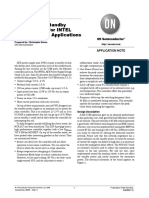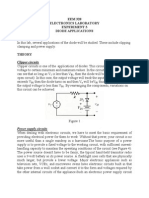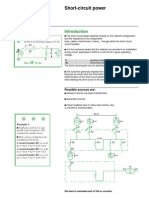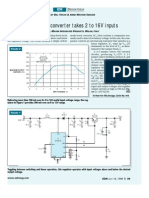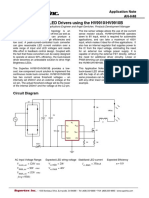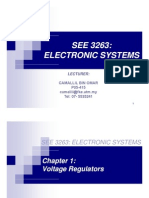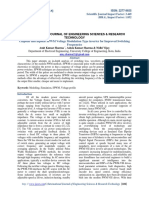AN954
AN954
Uploaded by
Fady HachemCopyright:
Available Formats
AN954
AN954
Uploaded by
Fady HachemCopyright
Available Formats
Share this document
Did you find this document useful?
Is this content inappropriate?
Copyright:
Available Formats
AN954
AN954
Uploaded by
Fady HachemCopyright:
Available Formats
2004 Microchip Technology Inc.
DS00954A-page 1
AN954
INTRODUCTION
There are several ways to convert an AC voltage at a
wall receptacle into the DC voltage required by a
microcontroller. Traditionally, this has been done with a
transformer and rectifier circuit. There are also switch-
ing power supply solutions, however, in applications
that involve providing a DC voltage to only the
microcontroller and a few other low-current devices,
transformer-based or switcher-based power supplies
may not be cost effective. The reason is that the
transformers in transformer-based solutions, and the
inductor/MOSFET/controller in switch-based solutions,
are expensive and take up a considerable amount of
space. This is especially true in the appliance market,
where the cost and size of the components surrounding
the power supply may be significantly less than the cost
of the power supply alone.
Transformerless power supplies provide a low-cost
alternative to transformer-based and switcher-based
power supplies. The two basic types of transformerless
power supplies are resistive and capacitive. This
application note will discuss both with a focus on the
following:
1. A circuit analysis of the supply.
2. The advantages and disadvantages of each
power supply.
3. Additional considerations including safety
requirements and trade-offs associated with
half-bridge versus full-bridge rectification.
Author: Reston Condit
Microchip Technology Inc.
Warning: An electrocution hazard exists during experimentation with transformerless circuits that interface to wall
power. There is no transformer for power-line isolation in the following circuits, so the user must be very
careful and assess the risks from line-transients in the users application. An isolation transformer should
be used when probing the following circuits.
Transformerless Power Supplies: Resistive and Capacitive
AN954
DS00954A-page 2 2004 Microchip Technology Inc.
CAPACITIVE TRANSFORMERLESS
POWER SUPPLY
A capacitive transformerless power supply is shown in
Figure 1. The voltage at the load will remain constant
so long as current out (IOUT) is less than or equal to
current in (IIN). IIN is limited by R1 and the reactance of
C1.
FIGURE 1: CAPACITIVE POWER SUPPLY
IIN is given by:
EQUATION 1:
EQUATION 2:
EQUATION 3:
Substituting Equation 2 and Equation 3 into Equation 1
results in:
EQUATION 4:
Note: R1 limits inrush current. The value of R1 is
chosen so that it does not dissipate too
much power, yet is large enough to limit
inrush current.
L
N
R1 D2
VOUT
D1
5.1V
C2
470 1/2W
IOUT
IIN
470 F
C1
.47 250V
IIN =
VHFRMS
IOUT
X
C1
+ R1
Where VHFRMS is the RMS voltage of a half-wave
AC sine wave and X
C1
is the reactance of C1.
VHFRMS = =
VPEAK VZ 2VRMS VZ
2 2
Where VPEAK is the peak voltage of the wall power,
VRMS is the rated voltage of wall power (i.e., United
States: 115 VAC, Europe: 220 VAC) and VZ is the
voltage drop across D1.
X
C1
=
1
2fC1
Where f is the frequency (i.e., United States: 60 Hz,
some countries: 50 Hz).
IIN = 2VRMS VZ
2
1
2 fC1+ R1
2004 Microchip Technology Inc. DS00954A-page 3
AN954
The minimum value of IIN should be calculated for the
application, while the maximum value of IIN should be
calculated for the power requirements of individual
components.
EXAMPLE 1: CALCULATE MINIMUM
POSSIBLE IIN
EXAMPLE 2: CALCULATE MAXIMUM
POSSIBLE IIN
VOUT is given by:
EQUATION 5:
Assuming a 5.1V zener diode and a 0.6V drop across
D2, the output voltage will be around 4.5V. This is well
within the voltage specification for PIC
microcontrollers.
OBSERVATIONS
Figure 2 shows an oscilloscope plot of VOUT at power-
up with a 10 k load on the output (between VOUT and
ground.) The 10 k load draws only 0.45 mA. As a
result, the rise time of VOUT is 280 ms (as fast as
possible for given IIN and C2), ripple is minimal when
VOUT stabilizes at the voltage calculated in Equation 5,
approximately 4.5V.
FIGURE 2: VOUT AT START-UP WITH 10 K LOAD
Assume minimum values of all components except VZ
and R1. Assume maximum value of VZ and R1.
VRMS = 110 VAC
VZ = 5.1V
f = 59.5 Hz
C = C1 = 0.47 F x 0.8 = 0.38 F
(assuming 20% capacitor)
R = R1 = 470 x 1.1 = 517 (assuming 10%
resistor)
IINMIN = 10.4 mA
Assume maximum values of all components except
VZ and R1. Assume minimum value of VZ and R1.
VRMS = 120 VAC
VZ = 5V
f = 60.1 Hz
C = C1 = 0.47 F x 1.20 = 0.56 F
(assuming 20% capacitor)
R = R1 = 470 x 0.9 = 423 (assuming 10%
resistor)
IINMAX = 16.0 mA
VOUT = VZ VD
Where VD is the forward voltage drop across D2.
AN954
DS00954A-page 4 2004 Microchip Technology Inc.
If the load is increased, the behavior of the circuit
changes in several ways. Figure 3 shows an oscillo-
scope plot of VOUT during the same time frame for a
500 load. A 500 load draws 9 mA at 4.5V. This is
near the 10.4 mA limit calculated in Example 1. The
rise time of VOUT is longer (680 ms) as expected
because not only is IOUT charging C2, but a significant
amount of current is being drawn by the load. VOUT
stabilizes at approximately 4.1V, about four tenths of a
volt below the output voltage calculated in Equation 5.
The ripple on VOUT is more pronounced with the
increased current draw.
FIGURE 3: VOUT AT START-UP WITH 500 LOAD
If even more current is demanded from the circuit, the
supply will stabilize at a voltage below the desired level.
Figure 4, shows an oscilloscope plot of VOUT during the
same time frame for a 270 load. A 270 load will
draw approximately 16 mA with an output voltage of
4.5V. This current cannot be provided by the circuit,
therefore, the output voltage is compromised.
FIGURE 4: VOUT AT START-UP WITH A 270 LOAD
2004 Microchip Technology Inc. DS00954A-page 5
AN954
POWER CONSIDERATIONS
Determining the power dissipation of the components
in the circuit is a critical consideration. As a general
rule, components should be selected with power
ratings at least twice the maximum power calculated for
each part. For AC components, the maximum RMS
values of both voltage and current are used to calculate
the power requirements.
Sizing R1:
The current through R1 is the full-wave current. This
current is equivalent to the line voltage divided by the
impedance of C1.
EQUATION 6:
Doubling this gives 0.46W, so a 1/2W resistor is
sufficient.
Sizing C1:
Assuming a maximum wall voltage of 120 VAC, double
this is 240V. A 250V X2 class capacitor will suffice.
Sizing D1:
D1 will be subjected to the most current if no load is
present. Assuming this worst case condition, D1 will be
subjected to approximately the full-wave current once
C2 is charged. This current was calculated when sizing
R1 (see above).
EQUATION 7:
Doubling this exceeds 1/4W, so a 1/2W 5.1V zener
diode is a good choice.
Sizing D2:
The maximum RMS current that will flow through D2
was calculated in Example 2. Assuming a 0.7V drop
across the resistor for half the wave, the following
equation (over) approximates the power dissipated in
D2.
EQUATION 8:
Sizing C2:
C2 should be rated at twice the voltage of the zener
diode. In this case, a 16V electrolytic capacitor will
work. C2 simply stores current for release to the load.
It is sized based on the ripple that is acceptable in
VOUT. VOUT with decay according to Equation 9.
EQUATION 9:
Advantages and Disadvantages
Advantages of Capacitive Power Supply:
1. Significantly smaller than a transformer-based
power supply.
2. More cost effective than a transformer-based or
switcher-based power supply.
3. Power supply is more efficient than a resistive
transformerless power supply (discussed next).
Disadvantages of Capacitive Power Supply:
1. Not isolated from the AC line voltage which
introduces safety issues.
2. Higher cost than a resistive power supply.
Note: The class of X2 capacitor is intended for
use in applications defined by IEC664
installation category II. This category
covers applications using line voltages
from 150 to 250 AC (nominal).
Pr1 = I
2
R = (VRMS*2fC)
2
R1
= (21.3 mA)
2
(470 x 1.1) = 0.23W
(assuming 10% resistor)
Pd1 = IxV = (21.3 mA)(5.1V) = 0.089W
Pd2 = IxV = (16.0 mA)(0.7V) = 0.011W
A 1/8 W rectifier is sufficient for D2.
Vout = Vd e
VD was calculated in Equation 5
-t
RC
AN954
DS00954A-page 6 2004 Microchip Technology Inc.
RESISTIVE TRANSFORMERLESS
POWER SUPPLY
A basic resistive transformerless power supply is
shown in Figure 5. Instead of using reactance to limit
current, this power supply simply uses resistance. As
with the capacitive power supply, VOUT will remain
stable as long as current out (IOUT) is less than or equal
to current in (IIN.)
FIGURE 5: RESISTIVE POWER SUPPLY
IIN is given by:
EQUATION 10:
EQUATION 11:
Substituting Equation 11 into Equation 10 results in:
EQUATION 12:
The minimum value of IIN should be calculated for the
application while the maximum value of IIN should be
calculated for power requirements.
EXAMPLE 3: CALCULATE MINIMUM
POSSIBLE IIN
EXAMPLE 4: CALCULATE MAXIMUM
POSSIBLE IIN
VOUT is the same as given for the capacitive power
supply (see Equation 5).
L
N
R1 D2
VOUT
D1
5.1V
C2
2K 10W
IOUT
IIN
470 F
IIN = IOUT
VHFRMS
R1
Where VHFRMS is the RMS voltage of a half-wave
AC sine wave.
VHFRMS =
VPEAK VZ
=
2VRMS VZ
2 2
Where VPEAK is the peak voltage of the wall power,
VRMS is the rated voltage of wall power (i.e., United
States: 115 VAC, Europe: 220 VAC), and VZ is the
voltage drop across D1.
IIN =
2VRMS VZ
2R1
Assume minimum value of VRMS. Assume maximum
value of VZ and R.
VRMS = 110 VAC
VZ = 5.1V
R = R1 = 2 k x 1.1 = 2.2 k (assuming
10% resistor)
IINMIN = 34.2 mA
Assume maximum value of VRMS. Assume minimum
value of VZ and R.
VRMS = 120 VAC
VZ = 5V
R = R1 = 2 k x 0.9 = 1.8 k (assuming
10% resistor)
IINMIN = 45.8 mA
2004 Microchip Technology Inc. DS00954A-page 7
AN954
OBSERVATIONS
The observations for the resistive power supply are
very similar to the capacitive power supply. Please refer
to the Observations in Section Capacitive Trans-
formerless Power Supply for more details.
Figure 6, Figure 7 and Figure 8 show VOUT at start-up
for the resistive power supply with loads of 10 k, 270
and 100, respectively. These loads correspond to out-
put currents of 0.45 mA, 16 mA and 45 mA, respec-
tively, assuming an output voltage of 4.5V. Clearly VOUT
is not 4.5V in Figure 6 because the current demand
placed on the power supply is too high.
FIGURE 6: VOUT AT START-UP WITH 10 K LO AD
FIGURE 7: VOUT AT START-UP WITH 270 LOAD
AN954
DS00954A-page 8 2004 Microchip Technology Inc.
FIGURE 8: VOUT AT START-UP WITH 100 LOAD
When working with an 60 Hz AC source, it is often
desirable to know when the line voltage crosses
Neutral. The crossing, known as zero-cross, can easily
be captured by connecting the node formed by D1, C1
and D2 to an input on the microcontroller. The
waveform observed at this node is shown in Figure 9.
For the resistive power supply, the transition in this
waveform occurs at the zero-cross. For capacitive
supplies, some delay is present due to the in-series
capacitor (C1 in Figure 1).
FIGURE 9: FIGURE A: WAVEFORM AT ZERO CROSS NODE
2004 Microchip Technology Inc. DS00954A-page 9
AN954
POWER CONSIDERATIONS
Selecting component power rating in the circuit is a
critical consideration. As a general rule, components
should be sized at twice the maximum power calcu-
lated for each device. For the AC components, the
RMS values of both voltage and current are used to
calculate the power requirements.
Sizing R1:
EQUATION 13:
A 10W resistor builds in 2 watts of safety so it will be
used.
Sizing D1:
With no load, the current through D1 will be
approximately equal to the full wave current through
R1.
EQUATION 14:
A 1 W 5.1V zener diode should be used.
Sizing D2:
The maximum RMS current that will flow through D2
was calculated in Example 4. Assuming a 0.7V drop
across the resistor for half the wave, the following
equation (over) approximates the power dissipated in
D2.
EQUATION 15:
A 1/8W diode is a sufficient for D2.
Sizing C2:
C2 should be rated at twice the voltage of the zener
diode. In this case, a 16V electrolytic capacitor will
work. C2 simply stores current for release to the load.
It is sized based on the voltage fluctuations that are
acceptable on VOUT. VOUT decays according to
Equation 9.
Advantages and Disadvantages
Advantages of Resistive Power Supply:
1. Significantly smaller than a transformer-based
power supply.
2. Lower cost than a transformer-based power
supply.
3. Lower cost than a capacitive power supply.
Disadvantages of Resistive Power Supply:
1. Not isolated from the AC line voltage which
introduces safety issues.
2. Power supply is less energy efficient than a
capacitive power supply.
3. Loss energy is dissipated as heat in R1.
PR1 = I
2
R =
V
2
R
(assuming 10% resistor)
2 k x 0.9
= 8W
120
2
PD1 = Vx1 = Vz
VRMS
R1
5.1V
120
2 k x 0.9
= 0.34W
PD2 = IxV = (45.8 mA)(0.7V) = 0.032W
AN954
DS00954A-page 10 2004 Microchip Technology Inc.
OTHER CONSIDERATIONS
Safety Considerations
FIGURE 10: CAPACITIVE POWER SUPPLY WITH SAFETY CONSIDERATIONS
Figure 10 shows a capacitive power supply with
several UL considerations designed in. A fuse is added
to protect the circuit during an over-current condition.
Adding R2 in parallel with C1 creates a filter that will
attenuate EMI from traveling back onto the line. A
varistor, or MOV, provides transient protection.
Figure 11 shows a resistive power supply with several
UL considerations
(1)
designed in.
FIGURE 11: RESISTIVE POWER SUPPLY WITH SAFETY CONSIDERATIONS
Disclaimer: This section does not provide all the information needed to meet UL requirements. UL requirements are
application specific and are not exclusive to the circuit design itself. Some of the other characteristics
that are factors in meeting UL requirements are trace width, trace proximity to one another, and (but not
limited to) other layout requirements. Visit the Underwriters Laboratories Inc. Web page at www.ul.com
for more information.
1M
R2
L
N
R1 D2
VOUT
D1
5.1V
C2
470 1/2W
IOUT
IIN
470
C1
.47 250V
Fuse
VR1
Note 1: User must research applicable UL
specifications that apply to the users
specific product. Products must be tested
by a certified lab to make sure all UL
requirements are met.
L
N
R1
D2
VOUT
D1
5.1V
C2
1K 5W
IOUT
IIN
R2
1K 5W
Fuse
VR1
470
C3
.047
R3
3M
2004 Microchip Technology Inc. DS00954A-page 11
AN954
As with the capacitive power supply, a fuse and varistor
have been added to provide over current and transient
protection respectively. The 2 k resistor is separated
into two 1 k in-series resistors. Series resistors
should be split into two resistors so that a high voltage
transient will not bypass the resistor. The use of the two
resistors also lowers the potential across the resistors,
reducing the possibility of arcing. C3 and R3 create a
filter which prevents EMI created by the circuit from
migrating onto the Line or Neutral busses.
FIGURE 12: RESISTIVE POWER SUPPLY WITH BRIDGE RECTIFIER
Bridge Rectification
The current output of each of the circuits described can
be increased by 141% with the addition of a low-cost
bridge rectifier. Figure 12 shows what the resistive
power supply looks like with this addition.
Instead of providing current during only one half of the
AC waveform period, current is supplied by the source
during both halves. Equation 16 gives the RMS voltage
for the full wave RMS voltage seen across R1.
EQUATION 16:
Substituting into Equation 10 gives an equation for IIN:
EQUATION 17:
Advantages of bridge rectifier over half-wave rectifier:
1. Provides 141% more current.
2. More efficient.
3. VOUT is more stable.
Disadvantages of bridge rectifier compared to
half-wave rectifier:
1. More expensive.
2. VOUT is not referenced to just line or neutral
making triac control impossible.
L
N
R1
VOUT
D1
5.1V
C2
5K 5W
IOUT
IIN
470
VFLRMS =
2VRMS VZ
2
IIN =
2VRMS VZ
2R
AN954
DS00954A-page 12 2004 Microchip Technology Inc.
CONCLUSION
Transformerless power supplies are instrumental in
keeping costs low in microcontroller-based applica-
tions powered from a wall receptacle. Both resistive
and capacitive power supplies offer substantial cost
and space savings over transformer-based and switch-
based supplies. Capacitive power supplies offer an
energy efficient solution, while resistive power supplies
offer increased cost savings.
REFERENCES
Transformerless Power Supply DSouza, Stan,
TB008, Microchip Technology Inc.
2004 Microchip Technology Inc. DS00954A-page 13
Information contained in this publication regarding device
applications and the like is intended through suggestion only
and may be superseded by updates. It is your responsibility to
ensure that your application meets with your specifications.
No representation or warranty is given and no liability is
assumed by Microchip Technology Incorporated with respect
to the accuracy or use of such information, or infringement of
patents or other intellectual property rights arising from such
use or otherwise. Use of Microchips products as critical
components in life support systems is not authorized except
with express written approval by Microchip. No licenses are
conveyed, implicitly or otherwise, under any intellectual
property rights.
Trademarks
The Microchip name and logo, the Microchip logo, Accuron,
dsPIC, KEELOQ, microID, MPLAB, PIC, PICmicro, PICSTART,
PRO MATE, PowerSmart, rfPIC, and SmartShunt are
registered trademarks of Microchip Technology Incorporated
in the U.S.A. and other countries.
AmpLab, FilterLab, MXDEV, MXLAB, PICMASTER, SEEVAL,
SmartSensor and The Embedded Control Solutions Company
are registered trademarks of Microchip Technology
Incorporated in the U.S.A.
Analog-for-the-Digital Age, Application Maestro, dsPICDEM,
dsPICDEM.net, dsPICworks, ECAN, ECONOMONITOR,
FanSense, FlexROM, fuzzyLAB, In-Circuit Serial
Programming, ICSP, ICEPIC, Migratable Memory, MPASM,
MPLIB, MPLINK, MPSIM, PICkit, PICDEM, PICDEM.net,
PICLAB, PICtail, PowerCal, PowerInfo, PowerMate,
PowerTool, rfLAB, rfPICDEM, Select Mode, Smart Serial,
SmartTel and Total Endurance are trademarks of Microchip
Technology Incorporated in the U.S.A. and other countries.
SQTP is a service mark of Microchip Technology Incorporated
in the U.S.A.
All other trademarks mentioned herein are property of their
respective companies.
2004, Microchip Technology Incorporated, Printed in the
U.S.A., All Rights Reserved.
Printed on recycled paper.
Note the following details of the code protection feature on Microchip devices:
Microchip products meet the specification contained in their particular Microchip Data Sheet.
Microchip believes that its family of products is one of the most secure families of its kind on the market today, when used in the
intended manner and under normal conditions.
There are dishonest and possibly illegal methods used to breach the code protection feature. All of these methods, to our
knowledge, require using the Microchip products in a manner outside the operating specifications contained in Microchips Data
Sheets. Most likely, the person doing so is engaged in theft of intellectual property.
Microchip is willing to work with the customer who is concerned about the integrity of their code.
Neither Microchip nor any other semiconductor manufacturer can guarantee the security of their code. Code protection does not
mean that we are guaranteeing the product as unbreakable.
Code protection is constantly evolving. We at Microchip are committed to continuously improving the code protection features of our
products. Attempts to break Microchips code protection feature may be a violation of the Digital Millennium Copyright Act. If such acts
allow unauthorized access to your software or other copyrighted work, you may have a right to sue for relief under that Act.
Microchip received ISO/TS-16949:2002 quality system certification for
its worldwide headquarters, design and wafer fabrication facilities in
Chandler and Tempe, Arizona and Mountain View, California in
October 2003. The Companys quality system processes and
procedures are for its PICmicro
8-bit MCUs, KEELOQ
code hopping
devices, Serial EEPROMs, microperipherals, nonvolatile memory and
analog products. In addition, Microchips quality system for the design
and manufacture of development systems is ISO 9001:2000 certified.
DS00954A-page 14 2004 Microchip Technology Inc.
AMERICAS
Corporate Office
2355 West Chandler Blvd.
Chandler, AZ 85224-6199
Tel: 480-792-7200
Fax: 480-792-7277
Technical Support:
480-792-7627
Web Address:
www.microchip.com
Atlanta
Alpharetta, GA
Tel: 770-640-0034
Fax: 770-640-0307
Boston
Westford, MA
Tel: 978-692-3848
Fax: 978-692-3821
Chicago
Itasca, IL
Tel: 630-285-0071
Fax: 630-285-0075
Dallas
Addison, TX
Tel: 972-818-7423
Fax: 972-818-2924
Detroit
Farmington Hills, MI
Tel: 248-538-2250
Fax: 248-538-2260
Kokomo
Kokomo, IN
Tel: 765-864-8360
Fax: 765-864-8387
Los Angeles
Mission Viejo, CA
Tel: 949-462-9523
Fax: 949-462-9608
San Jose
Mountain View, CA
Tel: 650-215-1444
Fax: 650-961-0286
Toronto
Mississauga, Ontario,
Canada
Tel: 905-673-0699
Fax: 905-673-6509
ASIA/PACIFIC
Australia - Sydney
Tel: 61-2-9868-6733
Fax: 61-2-9868-6755
China - Beijing
Tel: 86-10-8528-2100
Fax: 86-10-8528-2104
China - Chengdu
Tel: 86-28-8676-6200
Fax: 86-28-8676-6599
China - Fuzhou
Tel: 86-591-750-3506
Fax: 86-591-750-3521
China - Hong Kong SAR
Tel: 852-2401-1200
Fax: 852-2401-3431
China - Shanghai
Tel: 86-21-6275-5700
Fax: 86-21-6275-5060
China - Shenzhen
Tel: 86-755-8290-1380
Fax: 86-755-8295-1393
China - Shunde
Tel: 86-757-2839-5507
Fax: 86-757-2839-5571
China - Qingdao
Tel: 86-532-502-7355
Fax: 86-532-502-7205
ASIA/PACIFIC
India - Bangalore
Tel: 91-80-2229-0061
Fax: 91-80-2229-0062
India - New Delhi
Tel: 91-11-5160-8632
Fax: 91-11-5160-8632
Japan - Kanagawa
Tel: 81-45-471- 6166
Fax: 81-45-471-6122
Korea - Seoul
Tel: 82-2-554-7200
Fax: 82-2-558-5932 or
82-2-558-5934
Singapore
Tel: 65-6334-8870
Fax: 65-6334-8850
Taiwan - Kaohsiung
Tel: 886-7-536-4816
Fax: 886-7-536-4817
Taiwan - Taipei
Tel: 886-2-2500-6610
Fax: 886-2-2508-0102
Taiwan - Hsinchu
Tel: 886-3-572-9526
Fax: 886-3-572-6459
EUROPE
Austria - Weis
Tel: 43-7242-2244-399
Fax: 43-7242-2244-393
Denmark - Ballerup
Tel: 45-4420-9895
Fax: 45-4420-9910
France - Massy
Tel: 33-1-69-53-63-20
Fax: 33-1-69-30-90-79
Germany - Ismaning
Tel: 49-89-627-144-0
Fax: 49-89-627-144-44
Italy - Milan
Tel: 39-0331-742611
Fax: 39-0331-466781
Netherlands - Drunen
Tel: 31-416-690399
Fax: 31-416-690340
England - Berkshire
Tel: 44-118-921-5869
Fax: 44-118-921-5820
WORLDWIDE SALES AND SERVICE
08/24/04
You might also like
- K 43404896 - 03 - Mise en Service S5500 CO MX07Document120 pagesK 43404896 - 03 - Mise en Service S5500 CO MX07moh100% (3)
- Temperature Monitoring System FinalDocument49 pagesTemperature Monitoring System Finals_srireddy78% (9)
- TM 9 1220 239 34Document130 pagesTM 9 1220 239 34Costas Moraitis100% (1)
- AND8241/D A 5.0 V/2.0 A Standby Power Supply For INTEL Compliant ATX ApplicationsDocument16 pagesAND8241/D A 5.0 V/2.0 A Standby Power Supply For INTEL Compliant ATX ApplicationsJonatan LunaNo ratings yet
- Principles and Applications of The ICL7660 CMOS Voltage Converter PDFDocument10 pagesPrinciples and Applications of The ICL7660 CMOS Voltage Converter PDFPeter JordanNo ratings yet
- Phone Charger SchematicDocument6 pagesPhone Charger Schematicyudi_sibaraniNo ratings yet
- EEM328 Electronics Laboratory - Experiment 3 - Diode ApplicationsDocument3 pagesEEM328 Electronics Laboratory - Experiment 3 - Diode Applicationsdonatello84No ratings yet
- Merlin Gerin Medium VoltageDocument10 pagesMerlin Gerin Medium VoltagekjfenNo ratings yet
- Medium Voltage Swgr4Document3 pagesMedium Voltage Swgr4kjfens100% (1)
- Local Media5941271462837301265Document65 pagesLocal Media5941271462837301265jason mr.perfect11No ratings yet
- Power Supply DesignDocument8 pagesPower Supply DesignMario Plinio CrivelliNo ratings yet
- DC To Ac InverterDocument7 pagesDC To Ac InverterMuhammad Anim AkashNo ratings yet
- Designing With ReferencesDocument12 pagesDesigning With Referencesantares71No ratings yet
- BS7671 Formula and TipsDocument32 pagesBS7671 Formula and TipsjeevanNo ratings yet
- AND8076/D A 70 W Low Standby Power Supply With The NCP120x SeriesDocument14 pagesAND8076/D A 70 W Low Standby Power Supply With The NCP120x SeriesJonatan LunaNo ratings yet
- Three Phase Changer ProjectDocument42 pagesThree Phase Changer ProjectDaniel Taiti Kimathi100% (1)
- 9 Basic DC To DC Converter CircuitsDocument40 pages9 Basic DC To DC Converter Circuitsuser123phc100% (1)
- Flyback Converter Without SnubberDocument2 pagesFlyback Converter Without SnubberReena ElangovanNo ratings yet
- Tips N Tricks-MicrochipDocument20 pagesTips N Tricks-Microchipbanana567No ratings yet
- Resonant DC Link InvertersDocument6 pagesResonant DC Link InvertersSanchit AgarwalNo ratings yet
- Power Supply1Document6 pagesPower Supply1Sachin DarkundeNo ratings yet
- Mains Power SupplyDocument23 pagesMains Power SupplyTshepang SemenyaNo ratings yet
- And8142 DDocument10 pagesAnd8142 DJonatan LunaNo ratings yet
- DC-DC Conversion Without Inductors: Charge Pumps-A General DescriptionDocument8 pagesDC-DC Conversion Without Inductors: Charge Pumps-A General Descriptionaustinlee0502No ratings yet
- LV DESGIN FOR TRAINING Manual FinalDocument8 pagesLV DESGIN FOR TRAINING Manual FinalBehailu Mulugeta100% (1)
- EE 230 - Analog Lab - 2021-22/I (Autumn) Experiment 2: DC Power SupplyDocument5 pagesEE 230 - Analog Lab - 2021-22/I (Autumn) Experiment 2: DC Power SupplySruthiNo ratings yet
- DC Power SupplyDocument16 pagesDC Power SupplyChrisLeeNo ratings yet
- Block Diagram: Bridge RectifierDocument6 pagesBlock Diagram: Bridge Rectifierskull hertzNo ratings yet
- Voltage MultiplierDocument15 pagesVoltage MultiplierMohd Shafie Awang100% (1)
- UC2842 Philips AN1272 PDFDocument7 pagesUC2842 Philips AN1272 PDFupali01No ratings yet
- 2 V 73Document2 pages2 V 73Sameer SyedNo ratings yet
- dt97 3Document6 pagesdt97 3ofilipNo ratings yet
- Neutral Voltage Displacement - Application GuideDocument19 pagesNeutral Voltage Displacement - Application GuideRahul Yadav100% (2)
- Microprocessor Based Impedance RelayDocument11 pagesMicroprocessor Based Impedance RelayS Bharadwaj ReddyNo ratings yet
- Spice Model Laser Diode 15diDocument8 pagesSpice Model Laser Diode 15diParker333100% (1)
- MV Design Guide Design RulesDocument34 pagesMV Design Guide Design RulesAhmed Ibraheem100% (2)
- DC To Ac Converter by Using 555 Timer ICDocument6 pagesDC To Ac Converter by Using 555 Timer ICAlfred Adukobirre Adukobilla0% (1)
- Regulated DC Power Supply Lab AssignmentDocument17 pagesRegulated DC Power Supply Lab AssignmentSebastien Paul100% (1)
- An725 MaximDocument9 pagesAn725 MaximJavierNo ratings yet
- Problem Statement:: Fig. 1: Zener Diode SymbolDocument10 pagesProblem Statement:: Fig. 1: Zener Diode SymbolTalha JabbarNo ratings yet
- Buck Converter Design DemystifiedDocument6 pagesBuck Converter Design DemystifiedEric MorissetNo ratings yet
- High Voltage GenerationDocument41 pagesHigh Voltage Generationfiras alrawiNo ratings yet
- 9910 An-H48Document4 pages9910 An-H48Adii HernandezNo ratings yet
- Flipped Voltage Follower (Profe)Document4 pagesFlipped Voltage Follower (Profe)nos_joelNo ratings yet
- Constant-Power Source: Constant Power, Control Loop, Linear Voltage Regulator, High-Side Power/current MonitorDocument4 pagesConstant-Power Source: Constant Power, Control Loop, Linear Voltage Regulator, High-Side Power/current MonitorJonathan JaegerNo ratings yet
- Alimentation_5V a partir du secteur (MAXxxx)Document3 pagesAlimentation_5V a partir du secteur (MAXxxx)Marginal AmienNo ratings yet
- Voltage Drop After NEC RequirementsDocument3 pagesVoltage Drop After NEC Requirementsnadeem UddinNo ratings yet
- Lab 3Document11 pagesLab 3Praharsh VermaNo ratings yet
- Power Supplies TutorialDocument9 pagesPower Supplies TutorialBarry Bj ShaideNo ratings yet
- High Voltage DCDocument3 pagesHigh Voltage DCrameshbhatt007No ratings yet
- EC1254 Linear Integrated CircuitDocument24 pagesEC1254 Linear Integrated Circuittn22j8268No ratings yet
- Varistor Calculations (ID 16263)Document8 pagesVaristor Calculations (ID 16263)bspassov6100% (1)
- L200 Design GuideDocument21 pagesL200 Design Guidetxe_scientistNo ratings yet
- Power Factor Improvement: 1. Define Power Factor? Write Down The Disadvantages of Having Low Power Factor?Document39 pagesPower Factor Improvement: 1. Define Power Factor? Write Down The Disadvantages of Having Low Power Factor?Abrar Fahad AbirNo ratings yet
- 1.5v Battery ChargerDocument25 pages1.5v Battery ChargerJOHN BRICCO A. MATACSIL100% (1)
- Influence of System Parameters Using Fuse Protection of Regenerative DC DrivesFrom EverandInfluence of System Parameters Using Fuse Protection of Regenerative DC DrivesNo ratings yet
- Reference Guide To Useful Electronic Circuits And Circuit Design Techniques - Part 2From EverandReference Guide To Useful Electronic Circuits And Circuit Design Techniques - Part 2No ratings yet
- Reference Guide To Useful Electronic Circuits And Circuit Design Techniques - Part 1From EverandReference Guide To Useful Electronic Circuits And Circuit Design Techniques - Part 1Rating: 2.5 out of 5 stars2.5/5 (3)
- Design of Electrical Circuits using Engineering Software ToolsFrom EverandDesign of Electrical Circuits using Engineering Software ToolsNo ratings yet
- TA7230PDocument4 pagesTA7230PFady HachemNo ratings yet
- Androgen DeprivationDocument8 pagesAndrogen DeprivationFady HachemNo ratings yet
- DC DC Converter BOMDocument1 pageDC DC Converter BOMFady HachemNo ratings yet
- MC 34063 ADocument23 pagesMC 34063 AFady HachemNo ratings yet
- BD438Document5 pagesBD438Fady HachemNo ratings yet
- Application Note AN4105Document23 pagesApplication Note AN4105Fady HachemNo ratings yet
- Fly Back ConverterDocument1 pageFly Back ConverterFady HachemNo ratings yet
- Very Good: L 535.9 H The Core Is..Document1 pageVery Good: L 535.9 H The Core Is..Fady HachemNo ratings yet
- Prot BRD CMDocument1 pageProt BRD CMFady HachemNo ratings yet
- 2N60 PDFDocument7 pages2N60 PDFFady HachemNo ratings yet
- Smps v2.1 SCHDocument1 pageSmps v2.1 SCHFady Hachem0% (1)
- Slua 213Document5 pagesSlua 213Fady HachemNo ratings yet
- SMPS SchematicDocument1 pageSMPS SchematicFady HachemNo ratings yet
- Ir 21531Document1 pageIr 21531Fady HachemNo ratings yet
- Byv52 200Document7 pagesByv52 200Fady HachemNo ratings yet
- Application Note AN4105Document23 pagesApplication Note AN4105Fady HachemNo ratings yet
- Power Quality: Project ON Grid Connected PV SystemsDocument22 pagesPower Quality: Project ON Grid Connected PV SystemsRahul Radhakrishnan100% (1)
- P-Iii PLR 202Document11 pagesP-Iii PLR 202fahadullahNo ratings yet
- Electrical Electronics Engineering: Sssutms SehoreDocument16 pagesElectrical Electronics Engineering: Sssutms SehoreolexNo ratings yet
- Half Wave RectifierDocument2 pagesHalf Wave RectifiervinniNo ratings yet
- Ex5 (Ra2111003010611)Document15 pagesEx5 (Ra2111003010611)shubhamNo ratings yet
- TLE Major ReviewerDocument101 pagesTLE Major ReviewerDon Christian DemecilloNo ratings yet
- MC 34017Document9 pagesMC 34017Eric Fabian GómezNo ratings yet
- R48100G1Document2 pagesR48100G1Cristopher Rojas100% (1)
- Littelfuse Protection Relay IEEE Device Numbers and Sizing ChartsDocument1 pageLittelfuse Protection Relay IEEE Device Numbers and Sizing Chartssuni131No ratings yet
- Unmanned Petrol Bunk ProjectDocument87 pagesUnmanned Petrol Bunk ProjectUday Kumar60% (5)
- CCPF 3500 4000 ManualDocument15 pagesCCPF 3500 4000 ManualDarknezeusNo ratings yet
- LabVolt Industrial AC DrivesDocument121 pagesLabVolt Industrial AC Drivesumer farooqNo ratings yet
- D - Jayakumar Ece Ece Ece Viva Questions-JkDocument20 pagesD - Jayakumar Ece Ece Ece Viva Questions-Jktinku990056% (9)
- Wa0006.Document7 pagesWa0006.224033yogeshpadmanaban.jNo ratings yet
- Prerna Classes-AIEEE 2009 PhysicsDocument8 pagesPrerna Classes-AIEEE 2009 PhysicsSM200100% (1)
- Voltage RegulatorDocument106 pagesVoltage Regulatorpacai1987100% (5)
- Ower Electronics: By: MSC Eng. Ismaeil AlnaabDocument109 pagesOwer Electronics: By: MSC Eng. Ismaeil Alnaabعبدالرحمن محمد جاسم حمودNo ratings yet
- Texas Instruments. Testing A Form of SMPSDocument7 pagesTexas Instruments. Testing A Form of SMPSRoger FairchildNo ratings yet
- B340LA DiodesIncorporatedDocument4 pagesB340LA DiodesIncorporatedjonathandaviddelossantos146No ratings yet
- ED Unit-2Document22 pagesED Unit-2Naveen KadiyalaNo ratings yet
- Fra801G Thru Fra807G: 8.0 AMPS. Glass Passivated Fast Recovery RectifiersDocument2 pagesFra801G Thru Fra807G: 8.0 AMPS. Glass Passivated Fast Recovery RectifiersJose Luis LopezNo ratings yet
- DSG ValvesDocument17 pagesDSG ValvesChris RoederNo ratings yet
- The Welding Arc and Power Sources: Indian Institute of Welding - ANB Refresher Course - Module 14Document51 pagesThe Welding Arc and Power Sources: Indian Institute of Welding - ANB Refresher Course - Module 14dayalramNo ratings yet
- On The Steady-State Performance of A Synchronous Machine With Convertor: With Special Attention To Wind Energy Conversion SystemsDocument208 pagesOn The Steady-State Performance of A Synchronous Machine With Convertor: With Special Attention To Wind Energy Conversion Systemsgedeus8072No ratings yet
- MERCC02Document699 pagesMERCC02[C] GodoyNo ratings yet
- Power SupplyDocument28 pagesPower Supplybar catalinNo ratings yet
- Lab - Manual - Workshop - 2021-22Document78 pagesLab - Manual - Workshop - 2021-22sahayarvindkishorNo ratings yet
- Unipolar and Bipolar SPWM Voltage Modulation Type Inverter For Improved SwitchingDocument5 pagesUnipolar and Bipolar SPWM Voltage Modulation Type Inverter For Improved SwitchingOdnamra AlvarezNo ratings yet



